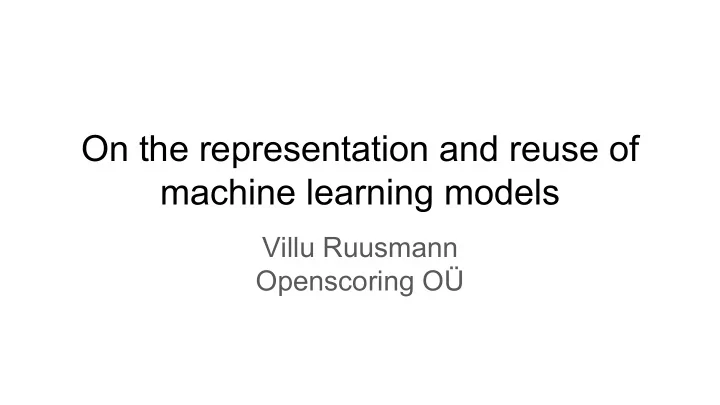

On the representation and reuse of machine learning models Villu Ruusmann Openscoring OÜ
https://github.com/jpmml 2
Def: "Model" Output = func(Input) 3
Def: "Representation" Generic Specific Data Application structure code 4
The problem "Train once, deploy anywhere" 5
A solution Matching model representation (MR) with the task at hand: 1. Storing a generic and stable MR 2. Generating a wide variety of more specific and volatile MRs upon request 6
The Predictive Model Markup Language (PMML) ● XML dialect for marking up models and associated data transformations ● Version 1.0 in 1999, version 4.3 in 2016 ● "Conventions over configuration" ● 17 top-level model types + ensembling http://dmg.org/ http://dmg.org/pmml/pmml-v4-3.html http://dmg.org/pmml/products.html 7
A continuum from black to white boxes Introducing transparency in the form of rich, easy to use, well-documented APIs: 1. Unmarshalling and marshalling 2. Static analyses. Ex: schema querying 3. Dynamic analyses. Ex: scoring 4. Tracing and explaining individual predictions 8
The Zen of Machine Learning "Making the model requires large data and many cpus. Using it does not" --darren https://www.mail-archive.com/user@spark.apache.org/msg40636.html 9
Model training workflow Real-world ML-platform ML-platform feature space feature space model 10
Model deployment workflow Real-world ML-platform ML-platform feature space feature space model vs. Real-world Real-world feature space model 11
Model resources R code Java code Scikit-Learn Original Optimized code PMML markup PMML markup Python code Apache Spark ML code Training Versioned storage Deployment 12
Comparison of model persistence options R Scikit-Learn Apache Spark ML Model data structure Fair to excellent Fair Poor stability Native serialization RDS (binary) Pickle (binary) SER (binary) and data format JSON (text) Export to PMML Few external N/A Built-in trait PMMLWritable Import from PMML Few external N/A JPMML projects JPMML-R and JPMML-SkLearn JPMML-SparkML r2pmml and sklearn2pmml (-Package) 13
PMML production: R library("r2pmml") auto <- read.csv("Auto.csv") auto$origin <- as.factor(auto$origin) auto.formula <- formula(mpg ~ (.) ^ 2 + # simple features and their two way interactions I(displacement / cylinders) + I(log(weight))) # derived features auto.lm <- lm(auto.formula, data = auto) r2pmml(auto.lm, "auto_lm.pmml", dataset = auto) auto.glm <- glm(auto.formula, data = auto, family = "gaussian") r2pmml(auto.glm, "auto_glm.pmml", dataset = auto) 14
R quirks ● No pipeline concept. Some workflow standardization efforts by third parties. Ex: caret package ● Many (equally right-) ways of doing the same thing. Ex: "formula interface" vs. "matrix interface" ● High variance in the design and quality of packages. Ex: academia vs. industry ● Model objects may enclose the training data set 15
PMML production: Scikit-Learn from sklearn2pmml import sklearn2pmml from sklearn2pmml.decoration import CategoricalDomain, ContinuousDomain audit_df = pandas.read_csv("Audit.csv") audit_mapper = DataFrameMapper([ (["Age", "Income", "Hours"], ContinuousDomain()), (["Employment", "Education", "Marital", "Occupation"], [CategoricalDomain(), LabelBinarizer()]), (["Gender", "Deductions"], [CategoricalDomain(), LabelEncoder()]), ("Adjusted", None)]) audit = audit_mapper.fit_transform(audit_df) audit_classifier = DecisionTreeClassifier(min_samples_split = 10) audit_classifier.fit(audit[:, 0:48], audit[:, 48].astype(int)) sklearn2pmml(audit_classifier, audit_mapper, "audit_tree.pmml") 16
Scikit-Learn quirks ● Completely schema-less at algorithm level. Ex: no identification of columns, no tracking of column groups ● Very limited, simple data structures. Mix of Python and C ● No built-in persistence mechanism. Serialization in generic pickle data format. Upon de-serialization, hope that class definitions haven't changed in the meantime. 17
PMML production: Apache Spark ML // $ spark-shell --packages org.jpmml:jpmml-sparkml-package:1.0-SNAPSHOT .. import org.jpmml.sparkml.ConverterUtil val df = spark.read.option("header", "true").option("inferSchema", "true").csv("Wine.csv") val formula = new RFormula().setFormula("quality ~ .") val regressor = new DecisionTreeRegressor() val pipeline = new Pipeline().setStages(Array(formula, regressor)) val pipelineModel = pipeline.fit(df) val pmmlBytes = ConverterUtil.toPMMLByteArray(df.schema, pipelineModel) Files.write(Paths.get("wine_tree.pmml"), pmmlBytes) 18
Apache Spark ML quirks ● Split schema. Static def via Dataset#schema() , dynamic def via Dataset column metadata ● Models make predictions in transformed output space ● High internal complexity, overhead. Ex: temporary Dataset columns for feature transformation ● Built-in PMML export capabilities leak the JPMML-Model library to application classpath 19
PMML consumption: Apache Spark ML // $ spark-submit --packages org.jpmml:jpmml-spark:1.0-SNAPSHOT .. import org.jpmml.spark.EvaluatorUtil; import org.jpmml.spark.TransformerBuilder; Evaluator evaluator = EvaluatorUtil.createEvaluator(new File("audit_tree.pmml")); TransformerBuilder pmmlTransformerBuilder = new TransformerBuilder(evaluator) .withLabelCol("Adjusted") // String column .withProbabilityCol("Adjusted_probability", Arrays.asList("0", "1")) // Vector column .exploded(true); Transformer pmmlTransformer = pmmlTransformerBuilder.build(); Dataset<Row> input = ...; Dataset<Row> output = pmmlTransformer.transform(input); 20
Comparison of feature spaces R Scikit-Learn Apache Spark ML Feature Named Positional Pseudo-named identification Feature data type Any Float, Double Double Feature operational Continuous, Continuous Continuous, type Categorical, Ordinal pseudo-categorical Dataset abstraction List< Map<String,?> > float[][] or double[][] List<double[]> Effect of Low Medium (sparse) to high (dense) transformations on dataset size 21
Feature declaration <DataField name="Age" dataType="float" optype="continuous"> <Interval closure="closedClosed" leftMargin="17.0" rightMargin="83.0"/> </DataField> <DataField name="Gender" dataType="string" optype="categorical"> <Value value="Male"/> <Value value="Female"/> <Value value="N/A" property="missing"/> </DataField> http://dmg.org/pmml/v4-3/DataDictionary.html <MiningField name="Age" outliers="asExtremeValues" lowValue="18.0" highValue="75.0"/> <MiningField name="Gender"/> http://dmg.org/pmml/v4-3/MiningSchema.html 22
Feature statistics <UnivariateStats field="Age"> <NumericInfo mean="38.30279" standardDeviation="13.01375" median="3.70"/> <ContStats> <Interval closure="openClosed" leftMargin="17.0" rightMargin="23.6"/> <!-- Intervals 2 through 9 omitted for clarity --> <Interval closure="openClosed" leftMargin="76.4" rightMargin="83.0"/> <Array type="int">261 360 297 340 280 156 135 51 13 6</Array> </ContStats> </UnivariateStats> <UnivariateStats field="Gender"> <Counts totalFreq="1899" missingFreq="0" invalidFreq="0"/> <DiscrStats> <Array type="string">Male Female</Array> <Array type="int">1307 592</Array> </DiscrStats> </UnivariateStats> 23 http://dmg.org/pmml/v4-3/Statistics.html
Comparison of tree models R Scikit-Learn Apache Spark ML Algorithms No built-in, many Few built-in Single built-in external Split type(s) Binary or multi-way; Binary; simple features simple and derived features Continuous features Rel. op. (<, <=) Rel. op. (<=) Categorical features Set op. (%in%) Pseudo-rel. op. (==) Pseudo-set op. Reuse Hard Easy to medium 24
Recommend
More recommend